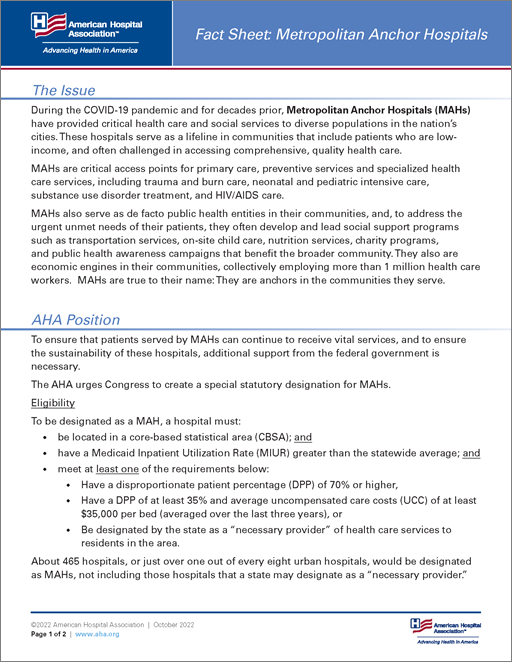Fact Sheet: Metropolitan Anchor Hospitals
The Issue
During the COVID-19 pandemic and for decades prior, Metropolitan Anchor Hospitals (MAHs) have provided critical health care and social services to diverse populations in the nation’s cities. These hospitals serve as a lifeline in communities that include patients who are low income, and often challenged in accessing comprehensive, quality health care.
MAHs are critical access points for primary care, preventive services and specialized health care services, including trauma and burn care, neonatal and pediatric intensive care, substance use disorder treatment, and HIV/AIDS care.
MAHs also serve as de facto public health entities in their communities, and, to address the urgent unmet needs of their patients, they often develop and lead social support programs such as transportation services, on-site child care, nutrition services, charity programs, and public health awareness campaigns that benefit the broader community. They also are economic engines in their communities, collectively employing more than 1 million health care workers. MAHs are true to their name: They are anchors in the communities they serve.
AHA Position
To ensure that patients served by MAHs can continue to receive vital services, and to ensure the sustainability of these hospitals, additional support from the federal government is necessary.
The AHA urges Congress to create a special statutory designation for MAHs.
Eligibility
To be designated as a MAH, a hospital must:
- be located in a core-based statistical area (CBSA); and
- have a Medicaid Inpatient Utilization Rate (MIUR) greater than the statewide average; and
- meet at least one of the requirements below:
- Have a disproportionate patient percentage (DPP) of 70% or higher,
- Have a DPP of at least 35% and average uncompensated care costs (UCC) of at least $35,000 per bed (averaged over the last three years), or
- Be designated by the state as a “necessary provider” of health care services to residents in the area.
About 465 hospitals, or just over one out of every eight urban hospitals, would be designated as MAHs, not including those hospitals that a state may designate as a “necessary provider.”
Why?
- MAHs bring tremendous value to the patients and communities they serve and to the nation’s health care system overall.
- MAHs serve a significant proportion of Medicare, Medicaid, and underinsured patients, and are therefore largely dependent on government payers and patients who are unable to pay for care.
- Public payers reimburse at much lower rates than private payers. Data from 2019 show Medicare underpayments to hospitals amounted to $56.8 billion; Medicaid underpayments amounted to $19.0 billion. Most patients who depend on MAHs for care are enrolled in one or both of these programs.
- Although MAHs represent 13% of all urban hospitals, nearly 40% of all Medicaid discharges are from MAHs.
- MAHs are heavily burdened by uncompensated care. In 2019 alone, MAHs reported nearly $15 billion in uncompensated care costs, which are defined as costs that are not paid for by either the patient or an insurer.
- MAHs are located in communities dealing with sustained hardships, whose patient populations have historically been marginalized. Seventy-five percent of MAHs are located in counties whose uninsured and poverty rates exceed the national average.
- Half of MAHs operated at a loss in 2019, more than twice the national average for all hospitals. The chronic underfunding of MAHs leaves these critical facilities without the necessary funds to repair and modernize their stressed infrastructures and makes them vulnerable to closures.
- MAHs are a key access point to behavioral health services for their patients and their communities.
Definitions
Core-based statistical area (CBSA): a geographic area in the United States centered around an urban area or large population center. CBSAs are defined by the U.S. Office of Management and Budget.
Medicaid inpatient utilization rate (MIUR): the ratio of inpatient days attributable to patients eligible for Medicaid to the total number of a hospital’s inpatient days. The formula for MIUR is defined in Medicaid statute (Social Security Act, Section 1923(b)(2)).
Disproportionate Patient Percentage (DPP): the ratio of Medicare inpatient days attributable to patients with both Medicare Part A and Supplemental Security Income (SSI) and the percentage of total inpatient days attributable to patients eligible for Medicaid but not entitled to Medicare Part A. The formula for DPP is defined in Medicare statute (Social Security Act, Section 1886(d)(5)(F)).
Uncompensated Care Costs (UCC): the total amount of costs hospitals incur for providing inpatient and outpatient care for which the hospital is not compensated. This includes charity care and non-Medicare bad debt, as defined by CMS. Uncompensated care does not include courtesy allowances, discounts given to patients that do not meet the hospital’s charity care policy, or discounts given to uninsured patients that do not meet the hospital’s financial assistance policy or bad debt reimbursed by Medicare.


